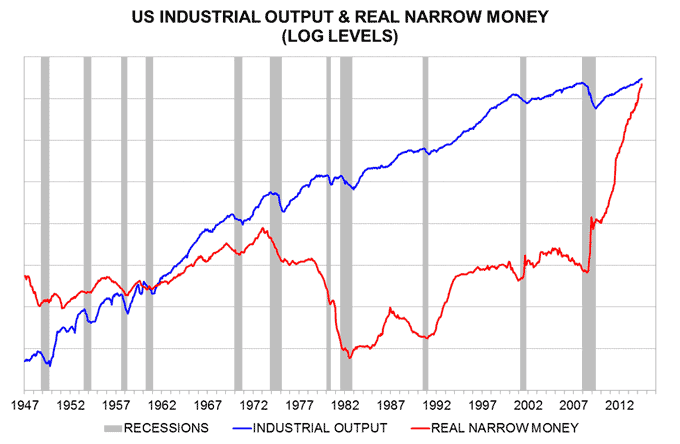Cycle analysis suggests 2016-17 US recession risk
A post last week suggested that economic fluctuations in recent decades can be explained by the interaction of three cycles. The current post applies this idea to post-WW2 US economic data.
The three cycles of interest are: the 3-5 year Kitchin stockbuilding cycle; the 7-11 year Juglar business investment cycle; and the 15-25 year Kuznets housebuilding cycle.
The upper part of the first chart shows the peak-to-trough declines in US industrial output in the 11 post-war recessions identified by the National Bureau of Economic Research (solid bars). Each decline is plotted in the year in which the recession trough occurred, e.g. the 2008-09 fall is plotted in 2009. A fall in output in 1966-67 is also included (outline bar), although the associated economic downswing did not qualify as a recession.
The lower part of the chart shows the trough years of the Kitchin, Juglar and Kuznets cycles. These troughs were identified judgementally by examining detrended national accounts data on stockbuilding, business investment and residential investment. Possible dates of future cycle troughs are also shown (outline bars).

This exercise yields the following insights.
First, as suggested in the earlier post, severe recessions occur when the three cycles reach a trough in the same year. There were three such years – 1958, 1975 and 2009. Industrial output declined by 14%, 13% and 17% respectively.
There was the potential for another synchronised trough in 1990-92. In the event, the three cycles bottomed a year apart. The associated recession was mild, measured in terms of the peak-to-trough industrial output. Economic weakness, however, was extended.
Secondly, years in which Kitchin and Juglar cycle troughs coincide are associated with “average” recessions. There were two such years – 1949 and 1982. Industrial output declined by 10% and 9% respectively.
There was the potential for synchronised Kitchin / Juglar troughs in 1967-68 and 2001-02 but, again, the cycles bottomed a year apart, so a recession was avoided in the former case and was mild in 2001.
Thirdly, Kitchin cycle troughs, in isolation, are not usually associated with recessions. There were 10 years in which the Kitchin cycle bottomed more than a year apart from the other two cycles. Recessions occurred in four of those years – 1954, 1961, 1970 and 1980. The 1954, 1970 and 1980 recessions were partly the result of “shocks” – significant fiscal tightening, a prolonged auto workers’ strike and the imposition of credit controls respectively.
The last Kitchin cycle trough occurred in 2012. There was no recession but economic weakness resulted in the Federal Reserve launching open-ended QE.
What are the implications for the timing of the next recession? The 3-5 year Kitchin cycle is scheduled to reach another trough between 2015 and 2017, while the 7-11 year Juglar cycle should bottom between 2016 and 2020. If the Kitchin trough is late and / or the Juglar trough arrives early, the cycles may synchronise, resulting in a recession. The most likely years for a recession to occur are 2016 and 2017, since the Kitchin cycle will embark on another upswing by 2018.
Note that these timings relate to cycle troughs. A 2016 recession trough would imply economic weakness beginning in 2015.
Monetary policy will affect the outcome. The Federal Reserve plans to raise interest rates gradually by about 2 percentage points between end-2014 and end-2016. This suggests a maximum negative impact on the economy in 2016-17, coinciding with cyclical vulnerability. Fed policy, that is, could deepen the Kitchin trough and bring forward the Juglar downswing, thereby increasing the risk of a recession.
If the Fed believes that a higher level of interest rates is necessary for medium-term inflation control reasons, there is a case for it making the adjustment by mid-2015 at the latest, while the Kitchin cycle is still in an upswing.
Any recession in 2016-17 should be of average or mild severity, since the 15-25 year Kuznets cycle is not scheduled to reach another trough until 2024 at the earliest.
How should recession risk be monitored? As discussed in a post in 2010, real narrow money contracted before 10 out the 11 post-WW2 recessions, the exception being the 1954 downturn, which – as noted earlier – had a large fiscal element*. Real narrow money is currently rising strongly, consistent with recent faster economic growth being sustained into early 2015, at least – second chart.
*Real government spending fell by 6.4% between 1953 and 1954.


Reader Comments